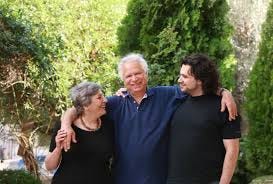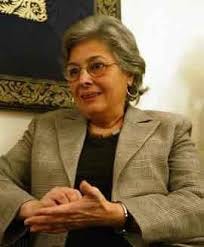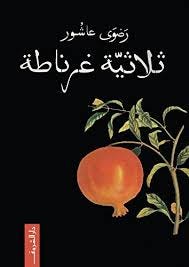Learning From Humanity's Worst Mistakes With 'Granada'
Also known as 'The Granada Trilogy' but this is it no new books
Unfortunately the Spanish Inquisition was not what Monty Python said it was.
History of the Time and the Author
I’m not a very good historian so here’s a fun little explainer if you need to get up to speed or need a refresher (you don’t have to watch it but for sure read the rest of the article):
Why this story was told has a lot to do with who wrote the story. So who was Radwa Ashour? She was a writer born in Manial to a lawyer father and poet/artist mother and each passed down artistic passion to her. She went on to receive a BA in English Literature and an MA in Comparative Literature from Cairo University then went on to earn a PhD from the University of Massachusetts Amherst with a concentration on African-American literature. She married college acquaintance and Palestinian poet Mouried Barghouti in 1970 and they had one son together named Tamim. Tamim is also a poet and he’s so good that he performed at the FIFA World Cup in Qatar.
Given Ashour’s interests, and what transpired in her marriage, she had a passion for speaking for the disenfranchised and the oppressed. The same day president Anwar Sadat landed in Tel Aviv in 1977, formally normalizing ties with Israel, her husband was deported back to occupied Palestine leaving her to raise their son alone. But she wasn’t going to be silenced and so created the National Committee Against Zionism to have universities operate their own chapters. And then she even protested against Mubarak era intolerance of dissent with her involvement of the March 9th protests calling for ideological independence of university professors from the Egyptian government.
Granada remains her most famous work to date. On November 30, 2014 Ashour passed away at the age of 68 from complications from her long battle with cancer.
Characters and Synopsis
Before we get into characters, I have read enough reviews on Goodreads to know that many readers, primarily American, think that there are another two books coming. There aren’t. The story started and ended in 1994. It is also referred to as The Granada Trilogy because the time span tells the story of one family over three generations across roughly thirty years. The years 1492 until 1527 to be exact. I’m hoping that little confusion gets cleared up from here on out but not surprised if it persists. I have been on the internet.
Abu Jaafar: The local papermaker of Albaicin in Granada and sometimes community leader. He takes in Naeem, employs Saad and makes it a point to give Hasan and Saleema robust and equal educations in Arabic.
Umm Jaafar: Wife of Abu Jaafar and usually the voice of reason when tempers flare in the house. She enjoys her family around her to make it lively and has an especially close relationship with Naeem over their shared love of gossip.
Umm Hasan: Real name Zaynab. Widow to Jaafar who died prior to the events of the novel. Neurotic mother of Hasan and Saleema and frequently butts heads with Maryama as the stereotypical mother in law.
Saad: An orphan from Malaga, the former manservant of Abu Mansour, Naeem’s best friend and eventually Saleema’s husband.
Naeem: Orphan taken in by Abu Jaafar at the very beginning of the novel and hopeless romantic.
Hasan: Grandson to Abu Jaafar and brother to Saleema and husband to Maryama. He errs on the side of caution when restrictions of Arab and Muslim life tighten and succeeds Abu Jaafar as the family patriarch.
Saleema: Granddaughter to Abu Jaafar and even shares his personality and love of knowledge, sister to Hasan and wife to Saad. She is stubborn, dreamy and becomes an apothecary to help her people through banned traditional means.
Abu Mansour: Local owner of the bathhouse and former boss of Saad. He serves as a cantankerous alternative father figure to Hasan, Naeem, Saad and Saleema and a type of local fixer.
Maryama: Wife of Hasan and the daughter of storytellers and musicians. She often is clever and funny with stories of messing with people for discriminating against Arabs or as a means of getting information out of Castilians.
SPOILERS!
The story starts when it follows Abu Jaafar and focuses on the whole of his family both naturally related and adopted as they try to navigate a new and imposing Castilian military presence in the neighborhoods of Albaicin and Ainadamar. After Abu Jaafar dies from despair over the Arabic book burning, Hasan must take the mantle of operating his paper making business (which shutters anyway) and Saleema takes on her grandfather’s resolve to not let the old ways fade with time. Umm Hasan and Umm Jaafar are determined to live life normally and practice Islam in secret in Granada until their deaths while best friends Naeem and Saad must navigate their lives separately in a society that will never accept them for who they are which are young Arab Muslim men.
Eventually Hasan and Maryama have five daughters and one son whom they try to keep safe while handling the loss of a culture before their very eyes. Saleema and Saad on the other hand dig their heels in by reading banned books and becoming freedom fighters respectively. Abu Mansour, for his part, loses his bathhouse when they are outlawed and cannot cope with family his family's legacy and so falls into alcoholism. Naeem finds his life and falls in love in the New World having been lost and drifting for so long in Granada with no one and nothing to tie him down. Saad spends six years with freedom fighters and comes back forever branded a criminal, Hasan and Maryama end up emotionally estranged (how dare he, she’s such a delight). Finally, Saleema gets arrested and burned at the stake for witchcraft and refusing to publicly admit fealty to Catholicism during her interrogation because of her apothecary practice.
What I Got Out of It
What stuck out to me was the vivid writing style that Ashour uses to flood the senses with imagery and mood. When happy there is light and food all around and so close I could hear the songs, sees the sights and smell the meals. The point is to be immersive because we have to know the richness of the culture that was there to feel the impact of not having it echoed in our present. In these practices, those too became a method of resistance. The simple act of sacrificing a sheep cannot be done to pray for another’s wellbeing. Storytelling about the time of the Prophet (PBUH) is increasingly risky and even speaking Arabic is completely forbidden.
“The people followed their eyes as the many copies of the Quran fell to the ground, both large and small, as the leather binding, embellished with exquisite engravings and magnificent script came apart.” (Ch. 5)
Next Saleema’s pet gazelle, who died early and suddenly, stayed with me after finishing the book. An engagement present from Saad, Saleema dotes on the creature until she must bury it in the seventh month of her first pregnancy. Something so beautiful is subject to a fate so tragic that not even in death could its memory be preserved. The death of the gazelle came to be a bad omen on things to come for Saleema. First her baby son passed away in the second month of his life giving way to a grief no one should experience. Then Saad leaves her for six years only to visit in the middle and get her pregnant a second time with a baby girl who survives. Next, in the twenty years that followed, Castilian judges desecrate the love she had for this animal by comparing a crudely drawn image of it to a billygoat that is meant to be the devil. They stop short of accusing Saleema of lying about the existence of the gazelle to insist she drew the billygoat that is the devil. Something so pure and short lived is taken and twisted and made to be seen as evil much in the same way as Saleema’s desire to help people with their ailments and the entire Muslim culture at large that the Castilians sought and succeeded in erasing.
Final Thoughts
“But reflection does not last long in the thick of torture, and terror mangles images and thoughts into pieces when the body is inflicted with wounds and the should convulses like a slaughtered bird.” (Ch. 20)
Coming away from this book there is a sense of sorrow for the real lost stories of the Moriscos that we will know. Even now, learning about this period of history and the existence of this civilization is not an easy thing to do. It conflicts with the narrative that Catholic Spain being a moral and righteous place that was ruled by good natured people only interested in returning the land to the path of God. It is very recently that we have started to dismantle that paradigm. The lesson, though, is to learn how to handle such tragedies either when learning about things past or about atrocities in the news. We can be bookish like Saleema, cautious like Hasan, humorous like Maryama, militant like Saad or choose to go our own way like Naeem.








